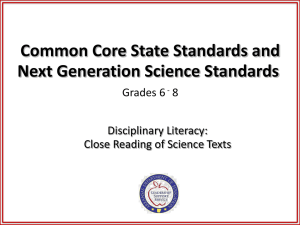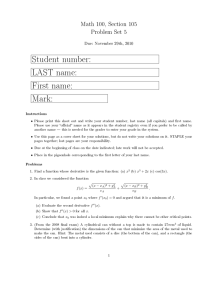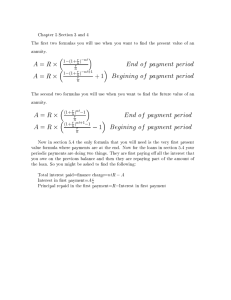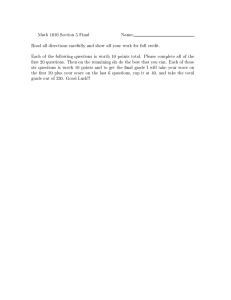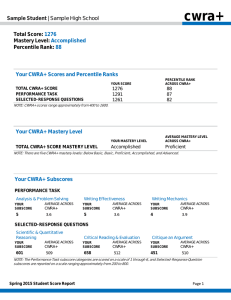Common Core Alignment
advertisement
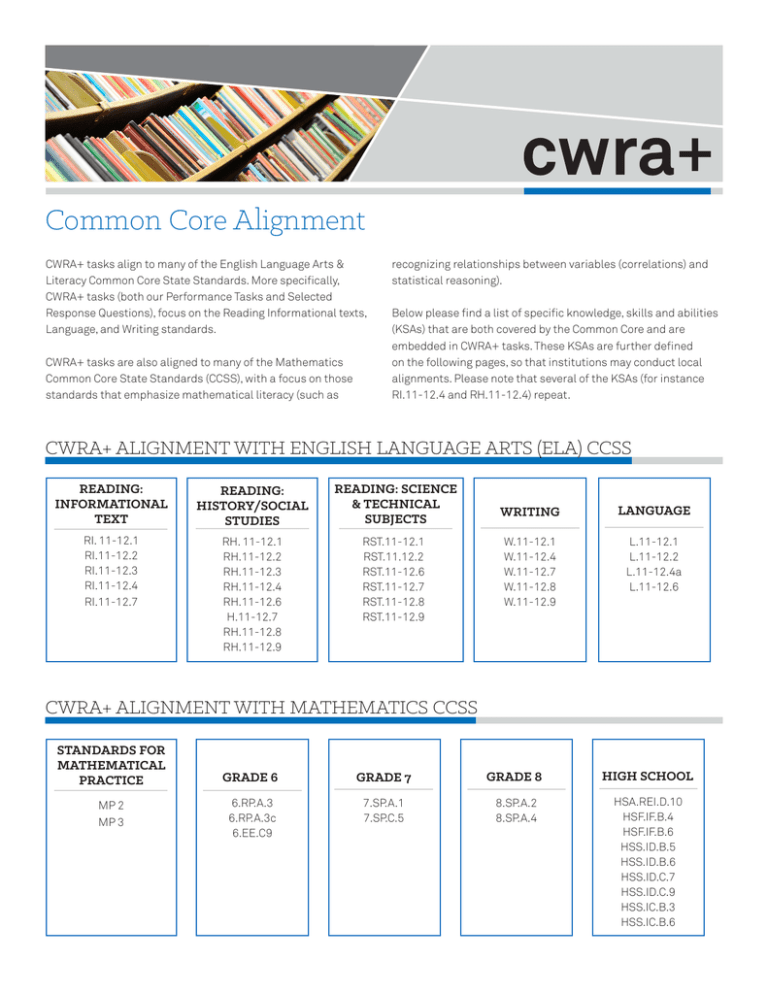
Common Core Alignment CWRA+ tasks align to many of the English Language Arts & Literacy Common Core State Standards. More specifically, CWRA+ tasks (both our Performance Tasks and Selected Response Questions), focus on the Reading Informational texts, Language, and Writing standards. CWRA+ tasks are also aligned to many of the Mathematics Common Core State Standards (CCSS), with a focus on those standards that emphasize mathematical literacy (such as recognizing relationships between variables (correlations) and statistical reasoning). Below please find a list of specific knowledge, skills and abilities (KSAs) that are both covered by the Common Core and are embedded in CWRA+ tasks. These KSAs are further defined on the following pages, so that institutions may conduct local alignments. Please note that several of the KSAs (for instance RI.11-12.4 and RH.11-12.4) repeat. CWRA+ ALIGNMENT WITH ENGLISH LANGUAGE ARTS (ELA) CCSS READING: INFORMATIONAL TEXT READING: HISTORY/SOCIAL STUDIES READING: SCIENCE & TECHNICAL SUBJECTS RI. 11-12.1 RI.11-12.2 RI.11-12.3 RI.11-12.4 RI.11-12.7 RH. 11-12.1 RH.11-12.2 RH.11-12.3 RH.11-12.4 RH.11-12.6 H.11-12.7 RH.11-12.8 RH.11-12.9 RST.11-12.1 RST.11.12.2 RST.11-12.6 RST.11-12.7 RST.11-12.8 RST.11-12.9 WRITING LANGUAGE W.11-12.1 W.11-12.4 W.11-12.7 W.11-12.8 W.11-12.9 L.11-12.1 L.11-12.2 L.11-12.4a L.11-12.6 CWRA+ ALIGNMENT WITH MATHEMATICS CCSS STANDARDS FOR MATHEMATICAL PRACTICE MP 2 MP 3 GRADE 6 GRADE 7 GRADE 8 HIGH SCHOOL 6.RP.A.3 6.RP.A.3c 6.EE.C9 7.SP.A.1 7.SP.C.5 8.SP.A.2 8.SP.A.4 HSA.REI.D.10 HSF.IF.B.4 HSF.IF.B.6 HSS.ID.B.5 HSS.ID.B.6 HSS.ID.C.7 HSS.ID.C.9 HSS.IC.B.3 HSS.IC.B.6 CWRA+ ALIGNMENT WITH ENGLISH LANGUAGE ARTS (ELA) CCSS Reading: Informational Text RI.11-12.1 Cite strong and thorough textual evidence to support analysis of what the text says explicitly as well as inferences drawn from the text, including determining where the text leaves matters uncertain. RI.11-12.2 Determine two or more central ideas of a text and analyze their development over the course of the text, including how they interact and build on one another to provide a complex analysis; provide an objective summary of the text. RI.11-12.3 Analyze a complex set of ideas or sequence of events and explain how specific individuals, ideas, or events interact and develop over the course of the text. RI.11-12.4 Determine the meaning of words and phrases as they are used in a text, including figurative, connotative, and technical meanings; analyze how an author uses and refines the meaning of a key term or terms over the course of a text. RI.11-12.7 Integrate and evaluate multiple sources of information presented in different media or formats (e.g., visually, quantitatively) as well as in words in order to address a question or solve a problem. Reading: History/Social Studies RH.11-12.1 Cite specific textual evidence to support analysis of primary and secondary sources, connecting insights gained from specific details to an understanding of the text as a whole. RH.11-12.2 Determine the central ideas or information of a primary or secondary source; provide an accurate summary that makes clear the relationships among the key details and ideas. RH.11-12.3 Evaluate various explanations for actions or events and determine which explanation best accords with textual evidence, acknowledging where the text leaves matters uncertain. RH.11-12.4 Determine the meaning of words and phrases as they are used in a text, including analyzing how an author uses and refines the meaning of a key term over the course of a text. RH.11-12.6 Evaluate authors’ differing points of view on the same historical event or issue by assessing the authors’ claims, reasoning, and evidence. RH.11-12.7 Integrate and evaluate multiple sources of information presented in diverse formats and media (e.g., visually, quantitatively, as well as in words) in order to address a question or solve a problem. RH.11-12.8 Evaluate an author’s premises, claims, and evidence by corroborating or challenging them with other information. RH.11-12.9 Integrate information from diverse sources, both primary and secondary, into a coherent understanding of an idea or event, noting discrepancies among sources. Reading: Science & Technical Subjects RST.11-12.1 Cite specific textual evidence to support analysis of science and technical texts, attending to important distinctions the author makes and to any gaps or inconsistencies in the account. RST.11-12.2 Determine the central ideas or conclusions of a text; summarize complex concepts, processes, or information presented in a text by paraphrasing them in simpler but still accurate terms. RST.11-12.6 Analyze the author’s purpose in providing an explanation, describing a procedure, or discussing an experiment in a text, identifying important issues that remain unresolved. RST.11-12.7 Integrate and evaluate multiple sources of information presented in diverse formats and media (e.g., quantitative data, video, multimedia) in order to address a question or solve a problem. RST.11-12.8 Evaluate the hypotheses, data, analysis, and conclusions in a science or technical text, verifying the data when possible and corroborating or challenging conclusions with other sources of information. RST.11-12.9 Synthesize information from a range of sources (e.g., texts, experiments, simulations) into a coherent understanding of a process, phenomenon, or concept, resolving conflicting information when possible. Writing W.11-12.1 Write arguments to support claims in an analysis of substantive topics or texts, using valid reasoning and relevant and sufficient evidence. W.11-12.4 Produce clear and coherent writing in which the development, organization, and style are appropriate to task, purpose, and audience. W.11-12.7 Conduct short as well as more sustained research projects to answer a question (including a self-generated question) or solve a problem; narrow or broaden the inquiry when appropriate; synthesize multiple sources on the subject, demonstrating understanding of the subject under investigation. W.11-12.8 Gather relevant information from multiple authoritative print and digital sources, using advanced searches effectively; assess the strengths and limitations of each source in terms of the task, purpose, and audience; integrate information into the text selectively to maintain the flow of ideas, avoiding plagiarism and overreliance on any one source and following a standard format for citation. W.11-12.9 Draw evidence from literary or informational texts to support analysis, reflection, and research. Language L.11-12.1 Demonstrate command of the conventions of standard English grammar and usage when writing or speaking. L.11-12.2 Demonstrate command of the conventions of standard English capitalization, punctuation, and spelling when writing. L.11-12.4a Use context (e.g., the overall meaning of a sentence, paragraph, or text; a word’s position or function in a sentence) as a clue to the meaning of a word or phrase. L.11-12.6 Acquire and use accurately general academic and domain-specific words and phrases, sufficient for reading, writing, speaking, and listening at the college and career readiness level; demonstrate independence in gathering vocabulary knowledge when considering a word or phrase important to comprehension or expression. CWRA+ ALIGNMENT WITH MATHEMATICS CCSS Standards for Mathematical Practice MP 2 Reason abstractly and quantitatively. Mathematically proficient students make sense of quantities and their relationships in problem situations. They bring two complementary abilities to bear on problems involving quantitative relationships: the ability to decontextualize—to abstract a given situation and represent it symbolically and manipulate the representing symbols as if they have a life of their own, without necessarily attending to their referents—and the ability to contextualize, to pause as needed during the manipulation process in order to probe into the referents for the symbols involved. Quantitative reasoning entails habits of creating a coherent representation of the problem at hand; considering the units involved; attending to the meaning of quantities, not just how to compute them; and knowing and flexibly using different properties of operations and objects. MP 3 Construct viable arguments and critique the reasoning of others. Mathematically proficient students understand and use stated assumptions, definitions, and previously established results in constructing arguments. They make conjectures and build a logical progression of statements to explore the truth of their conjectures. They are able to analyze situations by breaking them into cases, and can recognize and use counterexamples. They justify their conclusions, communicate them to others, and respond to the arguments of others. They reason inductively about data, making plausible arguments that take into account the context from which the data arose. Mathematically proficient students are also able to compare the effectiveness of two plausible arguments, distinguish correct logic or reasoning from that which is flawed, and—if there is a flaw in an argument—explain what it is. Students can listen or read the arguments of others, decide whether they make sense, and ask useful questions to clarify or improve the arguments. Standards for Mathematical Content 6.RP.A.3 Use ratio and rate reasoning to solve real-world and mathematical problems, e.g., by reasoning about tables of equivalent ratios, tape diagrams, double number line diagrams, or equations. 6.RP.A.3c Find a percent of a quantity as a rate per 100 (e.g., 30% of a quantity means 30/100 times the quantity); solve problems involving finding the whole, given a part and the percent. 6.EE.C.9 Use variables to represent two quantities in a realworld problem that change in relationship to one another; write an equation to express one quantity, thought of as the dependent variable, in terms of the other quantity, thought of as the independent variable. Analyze the relationship between the dependent and independent variables using graphs and tables, and relate these to the equation. 7.SP.A.1 Understand that statistics can be used to gain information about a population by examining a sample of the population; generalizations about a population from a sample are valid only if the sample is representative of that population. Understand that random sampling tends to produce representative samples and support valid inferences. 7.SP.C.5 Understand that the probability of a chance event is a number between 0 and 1 that expresses the likelihood of the event occurring. Larger numbers indicate greater likelihood. A probability near 0 indicates an unlikely event, a probability around 1/2 indicates an event that is neither unlikely nor likely, and a probability near 1 indicates a likely event. 8.SP.A.2 Know that straight lines are widely used to model relationships between two quantitative variables. For scatter plots that suggest a linear association, informally fit a straight line, and informally assess the model fit by judging the closeness of the data points to the line. 8.SP.A.4 Understand that patterns of association can also be seen in bivariate categorical data by displaying frequencies and relative frequencies in a two-way table. Construct and interpret a two-way table summarizing data on two categorical variables collected from the same subjects. Use relative frequencies calculated for rows or columns to describe possible association between the two variables. HSA-REI.D.10 Understand that the graph of an equation in two variables is the set of all its solutions plotted in the coordinate plane, often forming a curve (which could be a line). HSF-IF.B.4 For a function that models a relationship between two quantities, interpret key features of graphs and tables in terms of the quantities, and sketch graphs showing key features given a verbal description of the relationship. HSF-IF.B.6 Calculate and interpret the average rate of change of a function (presented symbolically or as a table) over a specified interval. Estimate the rate of change from a graph. HSS-ID.B.5 Summarize categorical data for two categories in two-way frequency tables. Interpret relative frequencies in the context of the data (including joint, marginal, and conditional relative frequencies). Recognize possible associations and trends in the data. HSS-ID.B.6 Represent data on two quantitative variables on a scatter plot, and describe how the variables are related. HSS-ID.C.7 Interpret the slope (rate of change) and the intercept (constant term) of a linear model in the context of the data. HSS-ID.C.9 Distinguish between correlation and causation. HSS-IC.B.3 Recognize the purposes of and differences among sample surveys, experiments, and observational studies; explain how randomization relates to each. HSS-IC.B.6 Evaluate reports based on data. CAE is a non-profit organization best known for its work measuring and improving the quality of secondary and postsecondary education. CAE features two nationwide assessment programs—the Collegiate Learning Assessment (CLA+) and the College & Work Readiness Assessment (CWRA+). These instruments provide members institutions with tools to improve critical thinking and writing skills through the connection of effective teaching, learning, and assessment efforts framed through authentic performance-based practices.
